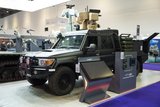Elbit Systems introduces foliage penetration radar
Elbit Systems has introduced a new radar called FPR-10 for the detection and tracking of threats in and beyond foliage, it announced on 10 November.
The radar has been designed for border protection and security of critical infrastructures, airports and seaports, especially in areas where forests and dense plantation can provide highly effective concealment for hostile threats.
FPR-10 offers extremely long-range foliage penetration for border protection and wide-area persistent surveillance. Based on Ground Surveillance Radar (GSR) technology, the system provides extremely high resolution, covers a very wide range in azimuth and elevation and enables target separation, allowing determination of the number of targets in the radar arena.
The system can simultaneously detect and track a variety of targets moving in various motion patterns and provide users with the coordinates and path of targets in a fully-digital display and output, for an enhanced operational picture.
With a Low False Alarm Rate (FAR), the system is easy to integrate and operate (via a pc/laptop), and has no moving parts, as opposed to previous GSR systems.
More from Digital Battlespace
-
![Babcock nears first customer for Nomad AI translation tool]()
Babcock nears first customer for Nomad AI translation tool
Nomad can provide militaries with real-time intelligence, saving critical time on the battlefield.
-
![AUSA 2025: Israel’s Asio Technologies to supply hundreds of improved Taurus tactical systems]()
AUSA 2025: Israel’s Asio Technologies to supply hundreds of improved Taurus tactical systems
Taurus operates alongside the Israel Defense Forces’ Orion system which supports mission management across tens of thousands of manoeuvring forces, from squad leaders to battalion commanders.
-
![AUSA 2025: Kopin pushes micro-LED plans as China moves faster]()
AUSA 2025: Kopin pushes micro-LED plans as China moves faster
The plan for the new displays follows fresh investment in Kopin’s European facilities by Theon and an order for head-up displays in fielded aircraft, with funding from the US Department of Defense.
-
![AUSA 2025: Persistent Systems to complete its largest order by year’s end]()
AUSA 2025: Persistent Systems to complete its largest order by year’s end
Persistent Systems received its largest ever single order for its MPU5 devices and other systems earlier this month and has already delivered the 50 units to the US Army’s 4th Infantry Division.
-
![Aselsan brings in dozens of companies and systems under the Steel Dome umbrella]()
Aselsan brings in dozens of companies and systems under the Steel Dome umbrella
Turkey has joined the family of countries attempting to establish a multilayered air defence system with government approval in August 2024 for the effort landed by Aselsan. Dubbed Steel Dome, the programme joins Israel’s Iron Dome, the US Golden Dome, India’s Mission Sudarshan Chakra and South Korea’s low-altitude missile defence system.
-
![DSEI 2025: MARSS unveils new agnostic multidomain C4 system]()
DSEI 2025: MARSS unveils new agnostic multidomain C4 system
MARSS’ NiDAR system has been deployed using sensors from static platforms to provide detection and protection for static sights, such as critical infrastructure, ports and military bases.




























